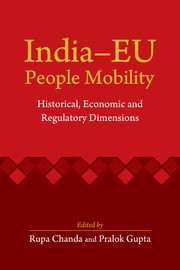Book contents
- Frontmatter
- Dedication
- Contents
- List of Tables, Figures and Boxes
- List of Abbreviations
- Preface
- Acknowledgements
- 1 India–EU People Mobility: Present Status and Policy Perspective
- 2 Economic Linkages and India–EU Mobility
- 3 Indian Diaspora in the EU
- 4 Goans in Portugal: History, Identity and Diaspora Linkages
- 5 Facilitating India–EU Mobility of IT Professionals
- 6 Movement of Indian Architects and Engineers: Prospects and Challenges in the EU
- 7 Mobility of Indian Legal Professionals to the EU: Understanding the EU's Regulatory Regime
- 8 Exploring India–EU Student Mobility
- 9 The Way Forward to a Strategic Engagement
- Contributors
- Index
Preface
Published online by Cambridge University Press: 05 January 2016
- Frontmatter
- Dedication
- Contents
- List of Tables, Figures and Boxes
- List of Abbreviations
- Preface
- Acknowledgements
- 1 India–EU People Mobility: Present Status and Policy Perspective
- 2 Economic Linkages and India–EU Mobility
- 3 Indian Diaspora in the EU
- 4 Goans in Portugal: History, Identity and Diaspora Linkages
- 5 Facilitating India–EU Mobility of IT Professionals
- 6 Movement of Indian Architects and Engineers: Prospects and Challenges in the EU
- 7 Mobility of Indian Legal Professionals to the EU: Understanding the EU's Regulatory Regime
- 8 Exploring India–EU Student Mobility
- 9 The Way Forward to a Strategic Engagement
- Contributors
- Index
Summary
The broad context
Cross-border mobility has emerged as one of the leading issues of our time. In 2013, the estimated number of migrants in the world stood at 231.5 million, around 4 per cent of the world's population, with 135 million located in developed countries and around 96 million in the developing and less developed countries. Given the widespread presence of migrants across the world and the large number of countries involved as destination and source markets for these flows, the discourse on cross-border temporary and permanent mobility has evolved over the years and, today, covers a complex range of issues. Policy and academic debates surrounding changes in immigration policy, irregular migration and the impact of migration on the local labour market and on the host economy and society are common place in countries that are destinations for foreign workers. Debates concerning brain drain, brain gain, and brain circulation, role of the diaspora, the need for supply capacity and alignment with global standards in professional training and education are common in countries of origin.
Although the potential benefits of international mobility in terms of enhanced economic, social, cultural and political relations are well recognized by both sending and receiving countries, the issue is fraught with regulatory and other concerns. It is, thus, not surprising that while all other dimensions of globalization such as international movement of goods, capital, technology and information have witnessed significant liberalization and harmonization in regulatory approach and frameworks across countries, international movement of people remains highly restricted by a plethora of regulations that vary from country to country and are subject to discretionary and unpredictable changes by sovereign governments. The latter is notwithstanding ample empirical evidence which indicates the significant welfare gains which can arise from liberalizing international mobility at the bilateral, regional and multilateral levels.
Against this backdrop, the role of India and the EU in the global labour market and their bilateral relationship through labour flows assumes significance. India and the EU are among the leading source and destination markets for international migrants. Between 1995 and 2005, Indian emigration flows reached 5.3 million, spread across a variety of regions and markets, including the Gulf states, the US, the UK, Canada, Australia, New Zealand, South East Asia and continental Europe.
- Type
- Chapter
- Information
- India–EU People MobilityHistorical, Economic and Regulatory Dimensions, pp. xv - xxiiPublisher: Cambridge University PressPrint publication year: 2015



